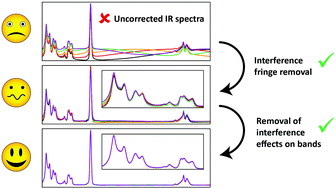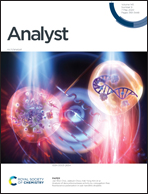Removing interference-based effects from infrared spectra – interference fringes re-revisited†
Abstract
Substantial refractive index mismatches between substrate and layers lead to undulating baselines, which are known as interference fringes. These fringes can be attributed to multiple reflections inside the layers. For thin and plane parallel layers, these multiple reflections result in wave interference and electric field intensities which strongly depend on the location within the layer and wavenumber. In particular, the average electric field intensity is increased in spectral regions where the reflectance is reduced. Therefore, the most important precondition for the Beer–Lambert law to hold, absorption as the single reason for electric field intensity changes, is no longer valid and, since absorption is proportional to the electric field intensity, considerable deviations from the Beer–Lambert law result. Fringe removal is consequently synonymous with correcting deviations from the Beer–Lambert law in the spectra. Within this contribution, we introduce an appropriate formalism based on wave optics, which allows a particularly fast and simple correction of any interference based effects. We applied our approach for correcting transmittance spectra of Poly(methyl methacrylate) layers on silicon substrates. The interference effects were successfully removed and correct baselines, in good agreement with the calculated spectra, were obtained. Due to its sound theoretical foundation, our formalism can be used as benchmark to test the performance of other methods for interference fringe removal.



 Please wait while we load your content...
Please wait while we load your content...